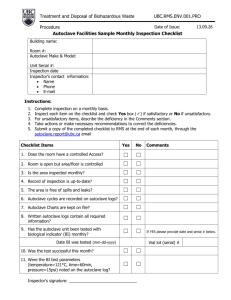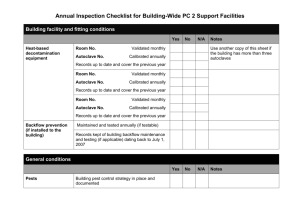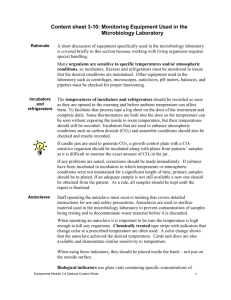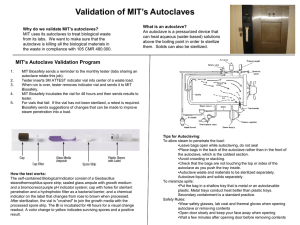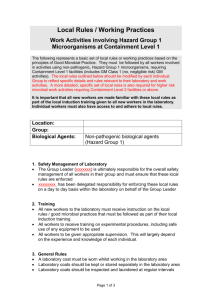Autoclave Design Considerations
advertisement
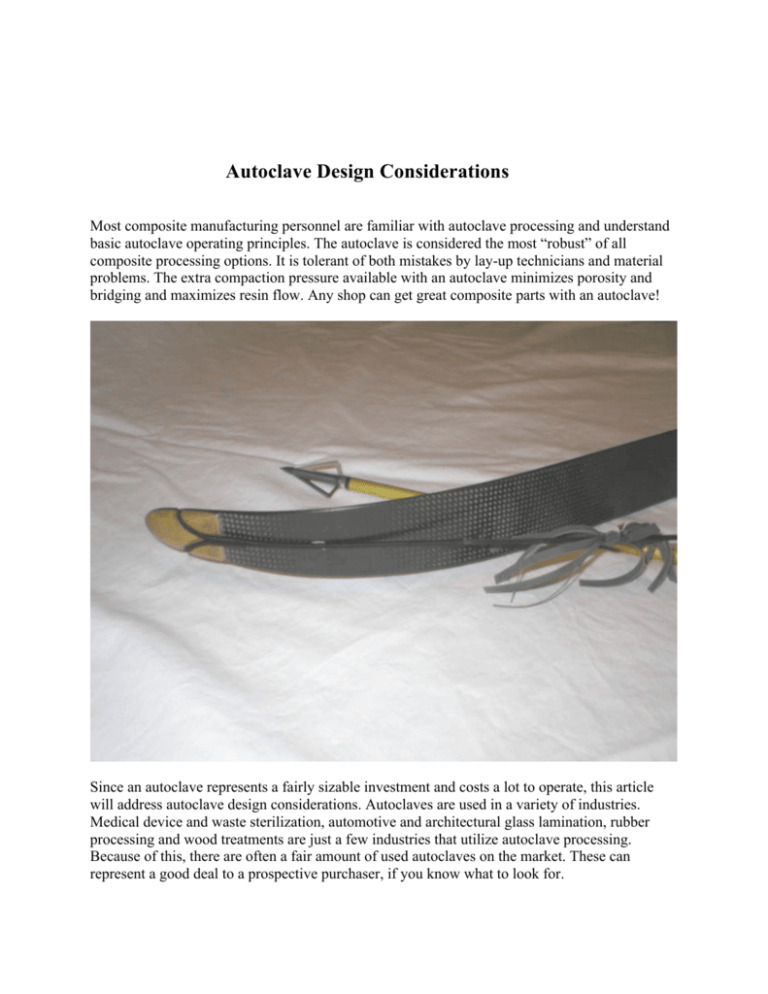
Autoclave Design Considerations Most composite manufacturing personnel are familiar with autoclave processing and understand basic autoclave operating principles. The autoclave is considered the most “robust” of all composite processing options. It is tolerant of both mistakes by lay-up technicians and material problems. The extra compaction pressure available with an autoclave minimizes porosity and bridging and maximizes resin flow. Any shop can get great composite parts with an autoclave! Since an autoclave represents a fairly sizable investment and costs a lot to operate, this article will address autoclave design considerations. Autoclaves are used in a variety of industries. Medical device and waste sterilization, automotive and architectural glass lamination, rubber processing and wood treatments are just a few industries that utilize autoclave processing. Because of this, there are often a fair amount of used autoclaves on the market. These can represent a good deal to a prospective purchaser, if you know what to look for. Pressure Vessel – Industrial pressure vessels are required to be manufactured to ASME “code” and should be inspected in accordance with various national board standards. This information, as well as the working pressure and temperature and original manufacturer should be listed on a data plate affixed permanently to the autoclave. Corrosion, stress and fatigue can weaken an autoclave over time. Used equipment should always be inspected for condition prior to being placed back in service. It is not unusual for vessel walls to be corroded to less than half their original wall thickness. Door hinges and locking mechanisms can suffer from wear and misalignment. Many were poorly designed and built to begin with. Welds can crack. Consider that 60 PSI behind a 6’ door is generating an opening force of over 100 tons. When purchasing new equipment, always specify inner working dimensions in length and diameter. Be aware that the fan, heat exchangers, plenums and insulation will take up significant internal volume. Speaking of insulation, if a pressure vessel is insulated externally, you will be heating and cooling the entire steel mass of the pressure vessel every time you run a load of parts. This is not only inefficient, but very hard on the structure and mechanical systems. We recommend a minimum of 4” internal rock wool insulation. Pressurization – Autoclaves can be pressurized with air or nitrogen, depending on customer requirements. Industry standard seems to be that air is OK up to temperatures of around 250 F. above 250 F, nitrogen is usually used to assist heat transfer and mitigate the potential for fire. Fires are not common, but they can cause a lot of damage to the autoclave itself. Losses could include a full load of parts and production down time while repairs are made. Fires can be caused by localized frictional heating from a bag leak and resin system exotherm. At higher pressures, more oxygen is available to feed the fire. Since the entire interior of the pressure vessel must be removed to inspect and repair an autoclave after a fire, nitrogen charging should be considered. Heat Transfer – Energy costs are rising and along with them, the cost of heating and cooling your autoclave. Heat transfer is a very large percentage of both the purchasing and operating cost of any type of composite processing equipment. For heating, the customer needs to choose between electric and gas. In the Southeastern United States, shops are often located very close to inexpensive sources of hydroelectric power. Anyone else is pretty much committed to natural gas for their process heating requirements. Fan size and heat exchanger design have a huge effect on your heating bill. Fan motors should be mounted internally, oversized and heat exchangers should be manufactured from 321H stainless steel. Specify it. This costs more “up front”, but will result in very long (10-15 year) heat exchanger service life. Cheaper heat exchanger constructions require repair every 3 to 5 years. This means complete disassembly and removal of the vessel interior, resulting in higher maintenance costs and more equipment down-time. High efficiency burners will not only lower your energy bills, but reduce Nox emissions. Along with a larger capacity fan, design of the plenums within the pressure vessel affect energy use and the rate at which an autoclave can heat and cool and load of parts. All things being equal, an annulus type plenum design is much more efficient than “under floor” heat exchangers and ducting. It will quickly pay for itself in the first year of operation and generate significant savings every year thereafter. Controls – A non-aerospace shop “batch” processing laminated glass or automotive parts can get away with a simplified control system. These folks might utilize a single vessel mounted thermocouple and run a single vacuum line to each part. As long as the parts can pass a visual inspection and look good, everyone is happy. We still recommend proportional vessel pressurization control valves, even for simple autoclaves. Operation is much smoother and the pressurization system components last much longer. More complex parts and tighter quality requirements call for more sophisticated controls. Multiple thermocouple channels and dual vacuum circuits per part have become pretty much standard in the aerospace industry. The autoclave itself should be run by a high quality PLC. We prefer Allen Bradley. They cost a little more, but reliability and support are very good. Control software should be “open source” with graphing and data logging capability. That is to say that you should own any software you purchase and have the right to make changes or modify its function to fit your application. Any responsible autoclave manufacturer will be more than happy to help you customize your software, teach you how to use and support it. Shops doing aerospace MRO type work often request a heat blanket control interface. That way, they can direct localized heating only into the bond repair and utilize the autoclave for pressure. A tremendous advantage of the autoclave is its flexibility and any control system should be carefully designed to take advantage of this. Safety – Any new or used autoclave considered for purchase should have all safety features and devices specified by applicable code. The door locking mechanism should be “fail safe”, meaning that you cannot pressurize the autoclave unless it is securely locked. Toggle bolt style door locking mechanisms are fine for lab autoclaves 18” in diameter or smaller. They are to be avoided for any autoclave used in a production environment. There is just too much chance of a worker improperly tightening the bolts and no real way to make them “fail safe”. Remember “Murphy’s Law”. If a mistake can be made, someone will eventually make it. Door or pressure vessel failures are potentially catastrophic, with serious injury or death a very real possibility. Every autoclave should receive a full safety inspection every year, with written results retained in your plant safety records. Most industrial insurance coverage now requires this. Conclusion – Composite manufacturer’s have a lot of process options available. VARTM, RTM, press and oven are only a few that come to mind. An autoclave offers manufacturing flexibility and a truly robust process. When you need perfect parts, nothing beats “delta P’. Steve Zeller is a manufacturer’s representative with over 25 years experience in composite manufacturing tooling, process equipment and materials. His company, www.southbrooktech.com represents www.autoclaves.com in the southeastern United States.



